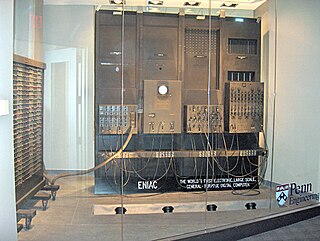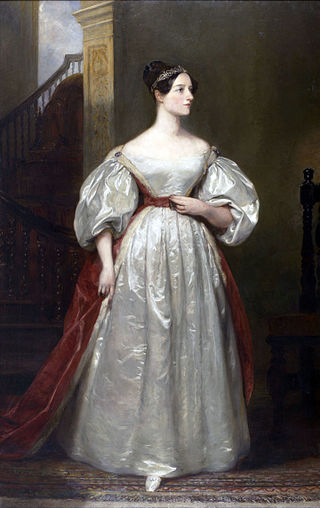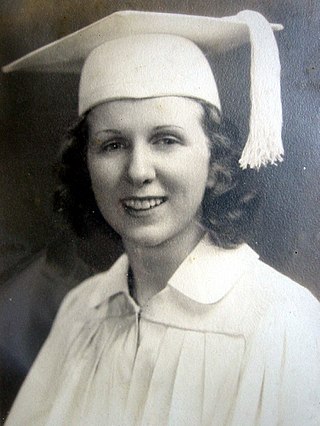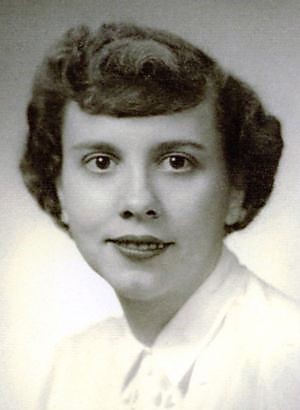Related Research Articles

Augusta Ada King, Countess of Lovelace was an English mathematician and writer, chiefly known for her work on Charles Babbage's proposed mechanical general-purpose computer, the Analytical Engine. She was the first to recognise that the machine had applications beyond pure calculation.

The LEO was a series of early computer systems created by J. Lyons and Co. The first in the series, the LEO I, was the first computer used for commercial business applications.

A computer programmer, sometimes referred to as a software developer, a software engineer, a programmer or a coder, is a person who creates computer programs.

ENIAC was the first programmable, electronic, general-purpose digital computer, completed in 1945. There were other computers that had combinations of these features, but the ENIAC had all of them in one computer. It was Turing-complete and able to solve "a large class of numerical problems" through reprogramming.

Women in computing were among the first programmers in the early 20th century, and contributed substantially to the industry. As technology and practices altered, the role of women as programmers has changed, and the recorded history of the field has downplayed their achievements. Since the 18th century, women have developed scientific computations, including Nicole-Reine Lepaute's prediction of Halley's Comet, and Maria Mitchell's computation of the motion of Venus.

Mary Lee Berners-Lee was an English mathematician and computer scientist who worked in a team that developed programs in the Department of Computer Science, University of Manchester Mark 1, Ferranti Mark 1 and Mark 1 Star computers. She was the mother of Sir Tim Berners-Lee, the inventor of the World Wide Web, and Mike Berners-Lee, an English researcher and writer on greenhouse gases.
Jean E. Sammet was an American computer scientist who developed the FORMAC programming language in 1962. She was also one of the developers of the influential COBOL programming language.

Frances Elizabeth Holberton was an American computer scientist who was one of the six original programmers of the first general-purpose electronic digital computer, ENIAC. The other five ENIAC programmers were Jean Bartik, Ruth Teitelbaum, Kathleen Antonelli, Marlyn Meltzer, and Frances Spence.
Adele Goldstine was an American mathematician and computer programmer. She wrote the manual for the first electronic digital computer, ENIAC. Through her work programming the computer, she was also an instrumental player in converting the ENIAC from a computer that needed to be reprogrammed each time it was used to one that was able to perform a set of fifty stored instructions.

Kathleen Rita Antonelli, known as Kay McNulty, was an Irish computer programmer and one of the six original programmers of the ENIAC, one of the first general-purpose electronic digital computers. The other five ENIAC programmers were Betty Holberton, Ruth Teitelbaum, Frances Spence, Marlyn Meltzer, and Jean Bartik.

Jean Bartik was one of the original six programmers of the ENIAC computer.

The Centre for Computing History is a museum in Cambridge, England, established to create a permanent public exhibition telling the story of the Information Age.

Mary Tsingou is an American physicist and mathematician of Greek descent. She was one of the first programmers on the MANIAC computer at Los Alamos National Laboratory and is best known for having coded the celebrated computer experiment with Enrico Fermi, John Pasta, and Stanislaw Ulam which became an inspiration for the fields of chaos theory and scientific computing and was a turning point in soliton theory.

Dina St Johnston was a British computer programmer credited with founding the UK's first software house in 1959.

This is a timeline of women in computing. It covers the time when women worked as "human computers" and then as programmers of physical computers. Eventually, women programmers went on to write software, develop Internet technologies and other types of programming. Women have also been involved in computer science, various related types of engineering and computer hardware.
Judith A. Clapp is a computer scientist who began her career at the Massachusetts Institute of Technology (MIT) and subsequently moved to the Lincoln Laboratory and then to MITRE, where she was a leader in the Semi-Automatic Ground Environment (SAGE) military project, including the development of the SAGE computer.
Hilary J. Kahn (1943–2007) was a South African British computer scientist who spent most of her career as a professor at the University of Manchester, where she worked on computer-aided design and information modelling. Kahn participated in the development of the Manchester MU5 computer. Later she became involved in standards development and was both the chair of the Technical Experts Group and a member of the Steering Committee for the development of the EDIF standard. Kahn retired from Manchester in 2006 and died in 2007.
Ann Hardy was an American computer programmer and entrepreneur, best known for her pioneering work on computer time-sharing systems while working at Tymshare from 1966 onwards.
Women have played a role in engineering in the United Kingdom for hundreds of years, despite the various societal barriers facing them. In the 18th and 19th century, there were few formal training opportunities for women to train as engineers and frequently women were introduced to engineering through family companies or their spouses. Some women did have more formal educations in the late 19th century and early 20th century, normally in mathematics or science subjects. There are several examples of women filing patents in the 19th century, including Sarah Guppy, Henrietta Vansittart and Hertha Ayrton.
Mary Ann Mansigh Karlsen is a computer programmer who was active in the 1950s in the use of scientific computers.
References
- ↑ "Mary Coombs". The British Library.
- 1 2 3 computingheritage (5 September 2013), Mary Coombs shares her story, YouTube, retrieved 26 July 2018
- ↑ Douglas, Ian (11 September 2013). "Bletchley Park celebrates women in computing". The Daily Telegraph. ISSN 0307-1235 . Retrieved 26 July 2018.
- ↑ "Women in Computing: a British Perspective – Google Arts & Culture". Google Cultural Institute. Retrieved 26 July 2018.
- ↑ "Mary Coombs – Computing History". www.computinghistory.org.uk. Retrieved 26 July 2018.
- ↑ "Museum celebrates women in computing". BBC News. 11 September 2013.
- 1 2 "Mary Coombs obituary". The Guardian. 11 March 2022. Retrieved 11 March 2022.
- 1 2 Bird, Peter J. (1994). LEO: the First Business Computer. Wokingham: Hasler Publishing Limited. ISBN 0-9521651-0-4.
- 1 2 3 4 5 "Mary Coombs". Diversity in HPC. Retrieved 14 April 2018.
- 1 2 "Oral-History:Mary Coombs – Engineering and Technology History Wiki". ethw.org. Retrieved 25 April 2021.
- ↑ "Meet LEO, the world's first business computer". Science Museum. Retrieved 17 November 2021.
- 1 2 3 Ferry, Georgina (2004). A Computer Called LEO: Lyons Tea Shops and the world's first office computer. Harper Perennial. p. 106. ISBN 1-84115-186-6.
- 1 2 Abbate, Janet (2012). Recoding gender : women's changing participation in computing. Cambridge, Mass.: MIT Press. ISBN 978-0-262-01806-7. OCLC 813929041.
- 1 2 3 "National Life Stories, an Oral History of British Science: Mary Coombs" (PDF). British Library Sounds. Oral History at the British Library. 7 May 2010. Retrieved 1 November 2016.
- ↑ "Mary Coombs 1929 – 2022 – Computing History". www.computinghistory.org.uk. Retrieved 11 March 2022.
- ↑ "Mary Coombs". The British Library. Retrieved 1 February 2017.
- ↑ Hicks, Marie (2017). Programmed Inequality: How Britain Discarded Women Technologists and Lost its Edge in Computing. Cambridge, MA: MIT Press. p. 87. ISBN 978-0-262-03554-5.
- ↑ "Women in Computing". Science Museum. Retrieved 16 November 2021.
- ↑ "Obit: Mary Coombs, first woman commercial programmer". www.theregister.com. Retrieved 12 March 2022.
- ↑ "Mary Coombs, pioneering woman programmer on LEO, the world's first business computer – obituary". The Daily Telegraph. 10 March 2022. Retrieved 11 March 2022.